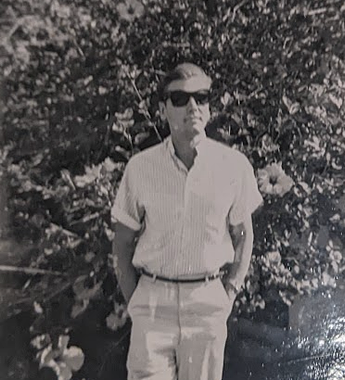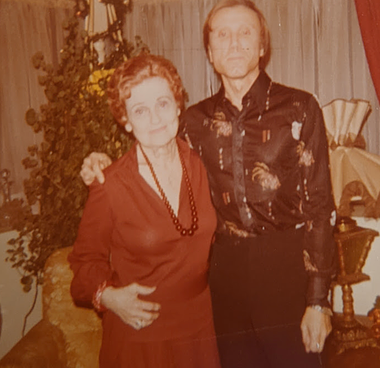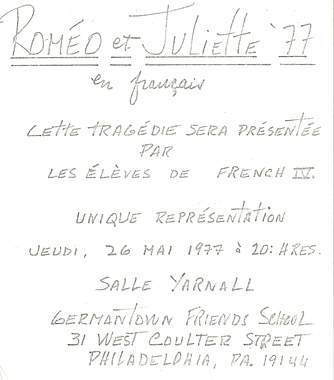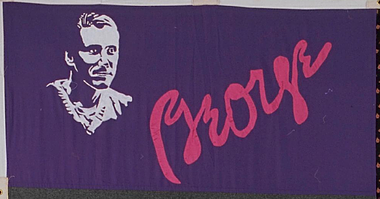Today would have been my great uncle George Bergman's 91st birthday. He contracted HIV and developed AIDS in the 80s and died in 1985. I never met him. Recently, I realized that since he didn't have any descendants, if I didn't ask my grandma about him soon, his story might be lost.

My grandma lovingly told me about George. Her brother loved music and played one of Chopin's polonaises before he ever had a piano lesson! He enjoyed singing (he was a tenor), playing the violin and piano (he and I learned on the same piano!), and going to the opera.

Their mother especially adored her golden boy, which I'm sure was hard for my grandma at times. There were quite a few pictures of him (as a child, he looked like one of my cousins!), and a few papers—letters from schools, news articles about him, and his funeral program.

When George died, my grandma was by his side in Philadelphia. One of the last things he said was, "There are so many astral people around."

I've enjoyed using library resources to research more about him—I found him in news articles and phone books, and was delighted to learn that he and my grandparents always lived within ten blocks of my favorite and longest-yet apartment in San Francisco!

I wish I could find people who knew him in the 50s and 60s in SF and NYC. My grandma said he was a music critic for an SF newspaper, but I've only been able to confirm that he worked on the San Francisco Examiner's classifieds and wrote one opera opinion piece. Every music critic has since died.


I wish I could find out the name(s) of George's partner(s) in New York City, San Francisco, Paris, and Philadelphia. Would he believe that gay marriage was legalized within his sister's lifetime? Did he face violence or arrests because he was gay? Did he join any early pride parades?
I'd heard different things about George's cause of death, so I requested a death certificate, but only immediate family members and direct descendants are allowed to receive a copy, which begs the question—what about decedents without descendants or living immediate family?

When I tried to request his transcript from SFSU to identify his major and graduation year, I was told I have to prove I was related. I'm trying to figure out how one does that—apparently a family tree isn't enough.
Thankfully, the SFSU university archivist was very responsive and easily found George's commencement program with his major (Italian) and graduation year (1962) that included a photo.

But one thing I keep thinking about was that big parts of his life are likely missing because the family didn't talk openly about George being gay, and he lived far away from family members still alive today.

So I started looking up some of George's former students who were named in an article about George's foreign language and performing arts video collection being donated to Germantown Friends School and found two who had talked about George in a Facebook post!
I ended up connecting with former students, a coworker, and the school's archivist, all of whom shared wonderful things! George was fashionable and always wrote with a purple flair pen. He had an “incredibly resonant voice with stylish cadences” (I'm trying to find a recording).

Despite the understood "don't ask, don't tell" attitude at the time, George made a welcoming space for closeted kids and faculty members. He earned respect by having no doubts about himself.

George recognized the school's opera queens and opera-interested and accompanied them, with his mother, to a New York opera and brunch at the World Trade Center restaurant Windows on the World, where he declared that everyone *must* see the amazing bathroom. (Anyone have a pic?)

Somehow, George was good friends with Coe Glade, a woman who held the world record for performing as Carmen in the opera the most times. He found out a coworker's mom loved opera as well and escorted her a few times, dressed very elegantly.

George played classical musical at "an ear-splitting volume." He showed up to support student songwriters and attended rock concerts with students. He surprised a coworker by telling her all about Pink Floyd.

Among George’s favorite movies were It’s a Wonderful Life, Sunset Boulevard, Casablanca, All About Eve, Ninotchka, Mr. Smith Goes to Washington, The Philadelphia Story, The Lion in Winter, Notorious, A Star is Born, Rebecca, The Little Foxes, Wuthering Heights, and Becket.
George organized a celebration of 100 years of recorded sound and played the best recordings—Enrico Caruso, Leopold Stokowski conducting . . . and a song written by student Joshua Newberg, after which he announced, “That of course was Rudolf Schmidt and the Vienna Quintet.”
His extracurricular activities were: “Photography, Piano, Swimming, Theatre, Tape Recording, Concerts, Cinema, the Nations of the World.” He put on Romeo and Juliet with his French students and Frenchified everyone's names in the program. Thank you, GFS archivist!

He put himself in positions where he could support people who needed support and had an instinct for what people needed to hear. He accepted a very out-of-character role in a play for a shy kid directing it and told a visiting graduate, “You have evolved” (in French).

When George died, people at the school said he'd died of cancer without mentioning George having AIDS, and they said it was to protect his mother. I think that with how close George and his mother were, she probably knew he was gay and that he had AIDS.
Student David Dunn Bauer said, "George was glamorous, and we as a Quaker school were not, but George treated us as if we were. If we’d been in NYC, he'd have worn a full-length mink and it would have been fabulous. I graduated in 1977, and every one of these memories of George is vivid. George does not fade."

George's friends at GFS made a quilt square for the NAMES Project AIDS Memorial Quilt in honor of George. It didn't take me long to find it, and I was surprised to recognize it as soon as I saw it. That cleft chin is unmistakable.


What a gift to learn all these things about George so I have a clearer picture of him on his birthday! I'm also writing about my Grandma's life and love and learning more about her when we chat once per week.
17 July 2023
Happy Birthday, Uncle George!
Labels:
family
Subscribe to:
Post Comments (Atom)




0 comments. I love comments!:
Post a Comment